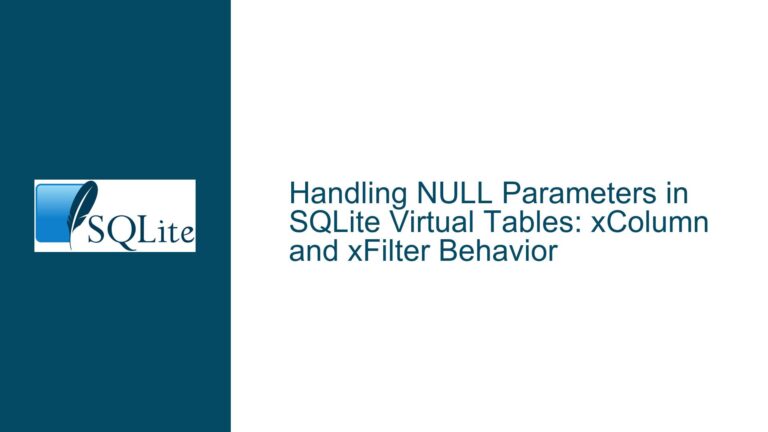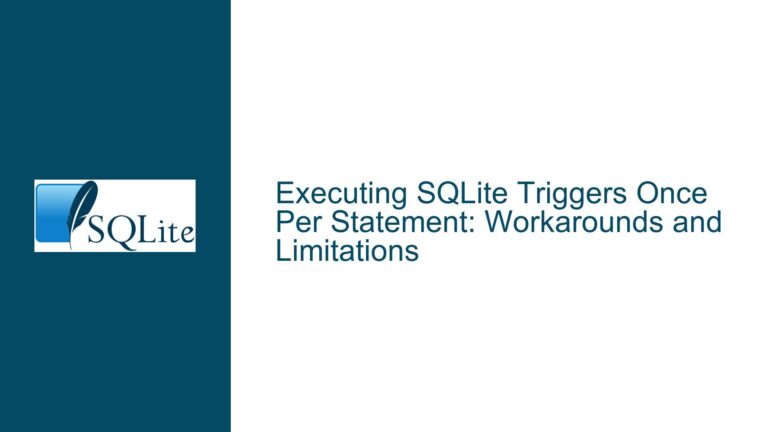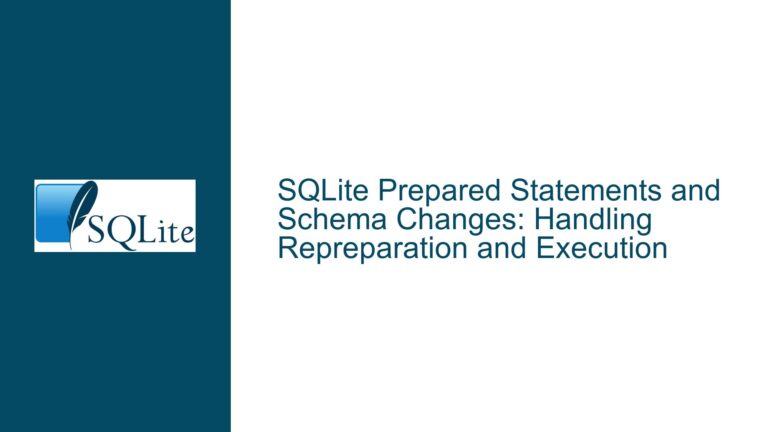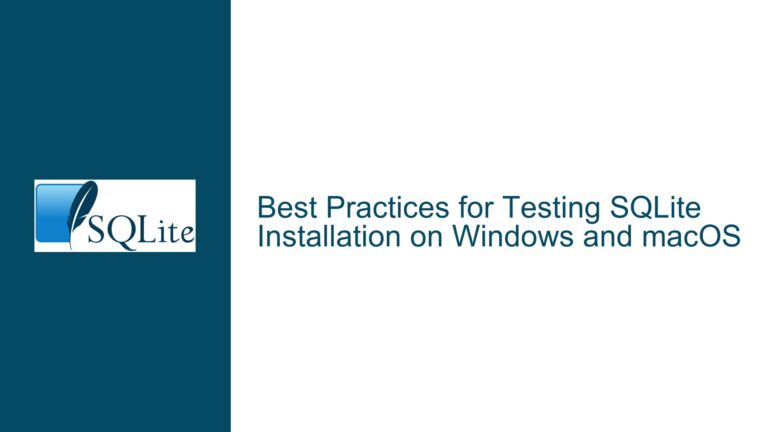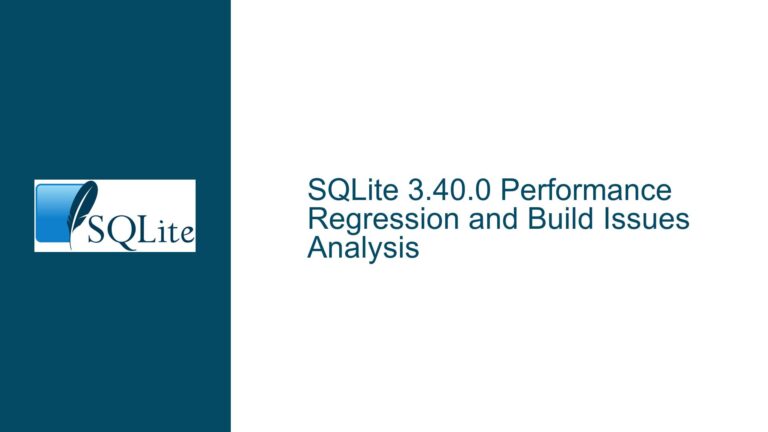Using SQLite as a Multi-Database Wrapper: Virtual Tables and Cross-Platform Challenges
Challenges in Implementing SQLite as a Multi-Database Abstraction Layer
The core idea of leveraging SQLite as a unified interface for heterogeneous databases (Oracle, SQL Server, PostgreSQL) introduces several technical and architectural challenges. The goal is to abstract away differences in SQL dialects, schema structures, and transactional semantics while enabling cross-database operations such as joins, caching, and query optimization. This approach relies heavily on SQLite’s virtual table mechanism, which allows external data sources to be represented as native SQLite tables.
Key Objectives and Benefits
- SQL Dialect Normalization: Over 90% of SQL operations (SELECT, INSERT, UPDATE, DELETE) could be standardized using SQLite’s syntax, reducing the need for database-specific code.
- Cross-Database Joins: Combine data from Oracle and SQL Server without requiring direct connectivity between the two systems.
- Local Caching: Use SQLite’s native storage as a transient cache for frequently accessed remote data.
- Credential Abstraction: Users interacting with the wrapper would not need direct credentials for underlying databases.
Critical Challenges
- Query Planning and Execution: SQLite’s query planner assumes all data is locally accessible. When virtual tables point to remote databases, join operations may require client-side processing, leading to latency and inefficiency.
- Transaction Coordination: Ensuring ACID compliance across multiple databases is inherently risky. Two-phase commit (2PC) protocols are theoretically possible but practically fragile due to network instability and database-specific transactional quirks.
- Index Propagation: While SQLite can leverage index metadata from remote databases, optimizations like index-only scans or predicate pushdown require deep integration with external query engines.
- Performance Overheads: Managed languages like C# introduce runtime penalties compared to native C implementations, especially for large datasets or complex joins.
- Schema Synchronization: Differences in data types (e.g., Oracle’s
NUMBERvs. SQL Server’sDECIMAL) and DDL syntax complicate schema replication.
Technical and Architectural Hurdles in Cross-Database Virtualization
Virtual Table Implementation Constraints
SQLite’s virtual table API requires developers to implement callback functions for row iteration, index usage, and data modification. For remote databases, these callbacks translate into network requests. For example:
- The
xBestIndexmethod must translate SQLite’s query constraints into WHERE clauses compatible with the remote database. - The
xOpenandxFiltermethods initiate cursor-like operations, fetching batches of rows from the remote source.
Latency and Data Transfer: A virtual table that fetches all rows from a remote table with SELECT * FROM oracle_table would incur significant latency if the result set is large. Pagination or predicate pushdown (sending filters to the remote server) is essential but non-trivial to implement.
Transaction Isolation and Atomicity
SQLite’s default transactional model assumes a single writer. When coordinating writes across multiple databases, conflicts arise:
- A transaction spanning Oracle and SQL Server cannot guarantee atomicity if one commit succeeds and the other fails.
- Savepoints and nested transactions are database-specific. Rolling back a nested transaction in SQL Server does not affect Oracle’s state.
Workaround Strategies:
- Compensating Transactions: Log changes and execute reversible operations if a distributed transaction fails. This violates ACID but provides eventual consistency.
- Read-Only Mode: Restrict virtual tables to read-only operations, as hinted in the discussion. This sidesteps write coordination but limits functionality.
Language and Performance Tradeoffs
The discussion highlights concerns about implementing virtual tables in C# via System.Data.SQLite versus native C. Key considerations:
- C# Virtual Tables: Managed code simplifies development but introduces overhead due to marshaling data between SQLite’s native API and .NET’s managed heap.
- Native C Extensions: Direct integration with SQLite’s C API offers maximal performance but requires interop mechanisms (P/Invoke) in .NET, complicating deployment.
Case Study: A virtual table fetching 100,000 rows from PostgreSQL via C# might take 2–3 seconds due to marshaling, while a C implementation could reduce this to milliseconds by avoiding managed/unmanaged transitions.
Dependency on Database-Specific Drivers
Oracle’s OCI (Oracle Call Interface), SQL Server’s ODBC drivers, and PostgreSQL’s libpq have unique behaviors:
- Connection pooling, timeout handling, and error recovery are driver-specific.
- Data type mappings (e.g., Oracle’s DATE vs. SQLite’s TEXT) require careful coercion.
Strategies for Building and Optimizing a SQLite-Based Multi-Database Solution
Step 1: Evaluate Virtual Table Implementations
Begin by prototyping a read-only virtual table for a single database (e.g., PostgreSQL). Use SQLite’s CREATE VIRTUAL TABLE statement with a module that maps to a remote table:
CREATE VIRTUAL TABLE pg_customers USING remotemodule(
connection='Host=127.0.0.1;Username=postgres',
query='SELECT id, name FROM customers'
);
- System.Data.SQLite: Test whether the .NET wrapper supports registering virtual table modules via
SQLiteModuleorSQLiteVirtualTable. Early experiments will reveal performance bottlenecks. - Predicate Pushdown: Implement
xBestIndexto forward WHERE clauses to the remote server. For example, a query likeSELECT * FROM pg_customers WHERE id > 100should translate toSELECT ... WHERE id > 100on PostgreSQL.
Step 2: Design a Hybrid Query Engine
For cross-database joins, combine SQLite’s local execution with remote filtering:
SELECT o.order_id, c.name
FROM oracle_orders o
JOIN pg_customers c ON o.customer_id = c.id
WHERE c.country = 'Germany';
- Remote Filtering: Push
c.country = 'Germany'to PostgreSQL. - Local Join: Fetch filtered customer IDs from PostgreSQL, then fetch matching orders from Oracle using
WHERE customer_id IN (...)in batches.
Step 3: Implement Caching with Write-Back Policies
Use SQLite tables as a cache layer:
CREATE TABLE cached_oracle_orders (
id INTEGER PRIMARY KEY,
customer_id INTEGER,
amount REAL,
last_refreshed TIMESTAMP
);
- Cache Invalidation: Use triggers or timestamps to expire stale data.
- Write-Back: Queue
INSERT/UPDATE/DELETEoperations in SQLite and periodically flush them to the remote database.
Step 4: Address Transactional Complexity
- Decouple Transactions: Treat each database as an independent transactional boundary. If a transaction involves Oracle and SQL Server, commit to Oracle first, then SQL Server. If the second commit fails, log the error and retry or alert the user.
- Compensation Example:
try { oracle.Commit(); sqlServer.Commit(); } catch (SqlException ex) { oracle.Execute($"DELETE FROM orders WHERE id = {lastOrderId}"); throw; }
Step 5: Benchmark and Optimize Data Transfer
- Batching: Fetch remote data in chunks (e.g., 1,000 rows per request) to reduce latency.
- Column Pruning: Avoid
SELECT *; fetch only columns needed by the active query. - Binary Serialization: Use protocol buffers or MessagePack for efficient data transfer between the wrapper and remote databases.
Step 6: Explore Alternatives and Hybrid Approaches
- DuckDB’s Multi-Database Support: DuckDB’s
sqlite_master-like interface for PostgreSQL/MySQL could supplement SQLite. However, Oracle support is absent. - Ibis Framework: Use Ibis in Python to generate SQL dialect-specific queries, but this doesn’t solve the .NET integration problem.
- Fallback to Passthrough Queries: For advanced SQL features (e.g., PostgreSQL’s JSONB functions), allow direct query passthrough without virtualization.
Step 7: Decide Between C# and Native C
- Prototype in C#: If performance with
System.Data.SQLiteis acceptable for small datasets, proceed with .NET. - Critical Paths in C: Offload performance-sensitive operations (e.g., row parsing) to a native DLL called via P/Invoke.
Step 8: Mitigate Schema and Data Type Discrepancies
- Type Mapping Tables: Define how each remote type maps to SQLite (e.g., Oracle’s
NUMBER(10)→ SQLite’sINTEGER). - Schema Synchronization Scripts: Use periodic jobs to align SQLite’s virtual table definitions with remote schema changes.
By systematically addressing these challenges, developers can create a robust multi-database wrapper that leverages SQLite’s simplicity while mitigating the complexities of distributed data management. The solution will inevitably involve tradeoffs between consistency, performance, and development effort, but the architectural benefits—unified querying, reduced dialect complexity, and credential abstraction—justify the investment for many use cases.

